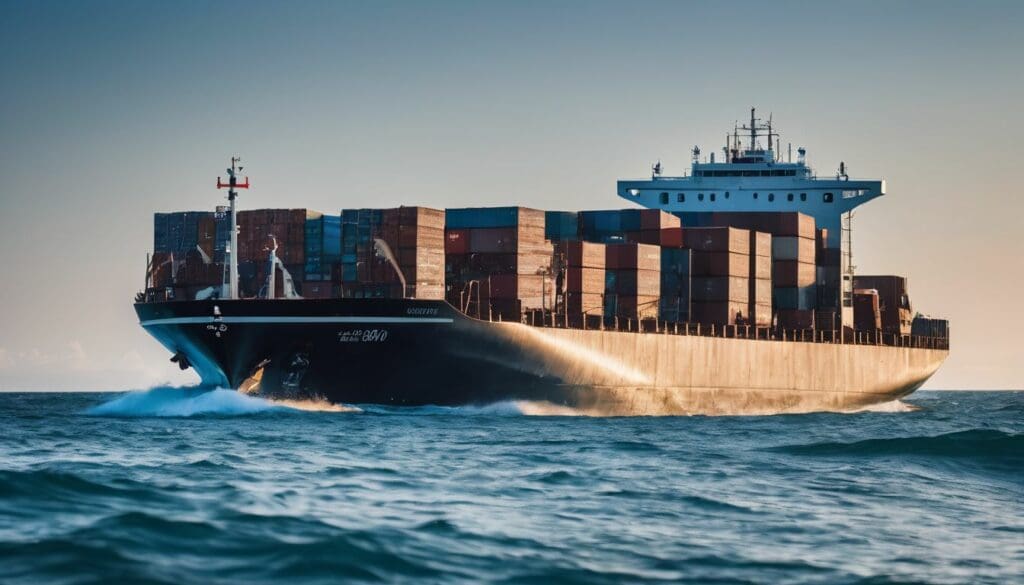The vast oceans that stretch before us do more than connect distant shores; they also bear a silent burden – the ecological impact of transporting our goods across their expanses.
Like many of you, we’ve witnessed the smog that clings to the wake of gargantuan freighters and recognised an urgent need for purer alternatives. After all, shipping activities are responsible for contributing 2.3% of global CO2 emissions, a figure we cannot ignore.
Our blog is poised to delve into the eco-friendly innovations propelling international commerce towards a brighter, greener future. Join us as we set sail on this journey through waves of change toward sustainability!
Key Takeaways
- Container ships contribute 2.3% of global CO2 emissions, but green shipping technologies could reduce this by over 30%.
- The CBP’s Green Trade Strategy is promoting sustainable practices in the shipping industry through incentives and stricter environmental regulations.
- Government and private sector collaboration is vital for implementing eco-friendly innovations like wind propulsion technology and low-carbon logistics.
- Technological improvements such as electric vessels, hybrid-powered ships, and energy-saving designs are key to advancing green shipping.
- By combining economic growth with environmental sustainability, the maritime industry can achieve a significant reduction in its carbon footprint while supporting global trade.
The Environmental Impact of Global Trade
The environmental impact of global trade is significant, with emissions from container ships and fossil fuels contributing to climate change and negative effects on the environment.
These impacts call for a shift towards more sustainable shipping practices in order to reduce the carbon footprint of international trade.
Emissions from container ships and fossil fuels
We know that the vast oceans are highways for global trade, with container ships crisscrossing them day and night. These massive vessels carry everything from electronics to clothing, fueling our passion for the latest game or gadget.
But they also emit a hefty amount of carbon dioxide, one of the greenhouse gases heating up our planet. In fact, around 2.3% of all global CO2 emissions stem from shipping activities.
Container ships predominantly run on what’s called bunker fuel – this is a heavy fossil fuel that’s cheaper than others but dirtier when it burns. Every journey across the sea adds more carbon to our atmosphere, contributing significantly to climate change.
It’s clear we need green shipping technology to tackle these emissions head-on. As gamers who care about detail and strategy in virtual worlds, let’s think similarly about real-world green strategies like wind power and alternative fuels that can dramatically lower pollution from these giants of the seas.
Negative effects on climate change and the environment
The negative effects of shipping on climate change and the environment are significant. Cargo shipping contributes nearly 3 per cent of global greenhouse gas emissions, with projections indicating a potential increase to 10% by 2050 if current growth rates continue.
These emissions exacerbate climate change, impacting ecosystems and weather patterns worldwide. Additionally, the release of sulphur dioxide from ships can contribute to ocean acidification, posing a severe threat to marine life.
Furthermore, maritime transport efficiency is also linked to other environmental issues such as noise pollution and oil spills which can have devastating impacts on marine habitats.
Greenhouse gas emissions from shipping also lead to air pollution in port cities and coastal areas where large volumes of freight are handled. This pollution has adverse health effects on local communities and adds strain to already vulnerable environments.
The Role of Shipping in Climate Change Mitigation
In the effort to mitigate climate change, the shipping industry plays a critical role in reducing its environmental impact. From embracing wind power and past technology to future-proofing, green shipping offers substantial benefits for sustainability and combating climate change.
With a focus on eco-friendly transport and renewable energy, the industry is taking proactive steps in promoting low-carbon logistics and clean technology.
The return of wind power in the shipping industry
Green shipping is embracing the return of wind power as a sustainable solution to reduce carbon emissions. Wind propulsion technology, such as sails and rotors, is being reintroduced in the maritime industry to harness wind energy for propelling ships.
This eco-friendly approach not only reduces greenhouse gas emissions but also aligns with the industry’s commitment to environmental sustainability. By integrating wind power into shipping operations, carbon emissions can be reduced by over 30 percent, contributing significantly to climate change mitigation and low-carbon logistics.
Furthermore, this shift towards renewable energy sources like wind power demonstrates the industry’s proactive stance in combatting negative impacts of climate change on global trade.
Past technology and future-proofing
The shipping industry is looking towards the future with innovative and eco-friendly technologies that can reduce carbon emissions by over 30 percent. In recent years, there has been a resurgence of wind power in the maritime sector, offering a sustainable alternative to traditional fossil fuel-powered engines.
This shift represents a proactive model to combat negative impacts of climate change and environmental degradation on trade. As technology evolves, so does the potential for green sea transport approaches to significantly decrease the industry’s carbon footprint while ensuring more environmentally friendly global trade.
Moving forward, it’s crucial for us to delve into strategies aimed at creating more sustainable practices within the shipping industry as we explore the benefits of green shipping and consider practical solutions for reducing its environmental impact.
Benefits of green shipping
Transitioning from past technology and future-proofing, let’s delve into the benefits of green shipping. Green sea transport approaches offer a proactive model to combat negative impacts of climate change and environmental degradation on trade.
By adopting cleaner technologies and methods, the shipping industry has the potential to reduce its carbon emissions by over 30 percent, contributing significantly to global efforts in mitigating climate change.
Additionally, with a proactive green transition, the shipping sector can markedly improve its environmental impact. Leveraging eco-friendly transport not only reduces emissions but also strengthens environmental enforcement measures.
Strategies for a More Sustainable Future for Trade
One of the key strategies for a more sustainable future in global trade is CBP’s Green Trade Strategy, which focuses on incentivising green trade and strengthening environmental enforcement.
Additionally, accelerating green innovation and improving climate resilience are also vital components in reducing the environmental impact of shipping.
CBP’s Green Trade Strategy
- Implementing stricter regulations on emissions from container ships and fossil fuels to reduce their negative effects on climate change and the environment.
- Incentivising green trade by offering benefits and rewards for companies that prioritise low-carbon logistics and eco-friendly transport options.
- Strengthening environmental enforcement to ensure that shipping companies adhere to green maritime transport standards, thus minimising their carbon footprint.
- Accelerating green innovation within the industry by encouraging the adoption of cleaner technologies and methods to significantly reduce environmental impact.
Incentivising green trade
- Offering tax incentives for companies that invest in green technologies or utilise low-carbon logistics.
- Providing subsidies for vessels that meet strict environmental standards and emission reduction targets.
- Creating financial rewards for ships that operate with reduced emissions or use alternative fuels, such as biofuels or hydrogen.
- Establishing a certification system that grants preferential treatment to shippers who adhere to stringent environmental regulations.
- Developing initiatives that link reduced port fees and quicker turnaround times to the adoption of eco-friendly practices.
Strengthening environmental enforcement
As we delve into the crucial aspects of creating a more sustainable future for global trade, strengthening environmental enforcement emerges as a pivotal strategy. With regulations and policies in place to ensure compliance with eco-friendly practices, the shipping industry can significantly reduce its carbon footprint.
By rigorously enforcing environmental standards, such as emissions limits and waste disposal regulations, authorities can hold shipping companies accountable for their impact on the environment.
Through stringent monitoring and robust penalties for non-compliance, governments and international bodies play a vital role in driving the shift towards greener shipping practices.
Accelerating green innovation
Transitioning from strengthening environmental enforcement, we can further focus on accelerating green innovation in the shipping industry. The advancement of sustainable technologies and practices is crucial to significantly reducing the environmental impact of global trade.
By incentivising research and development in eco-friendly transport and low-carbon logistics, we can drive the adoption of cleaner technologies and methods within the shipping sector.
One notable solution involves leveraging wind power for ship propulsion, a traditional practice being revived with modern innovations. Additionally, investments in innovative propulsion systems and alternative fuels are key drivers for greening the industry.
Improving climate resilience and resource efficiency
Transitioning from accelerating green innovation, improving climate resilience and resource efficiency is crucial for the future of global trade. By implementing sustainable practices and technologies, such as eco-friendly fuels and energy-efficient propulsion systems, the shipping industry can reduce its carbon footprint.
Embracing low-carbon logistics not only minimises environmental impact but also enhances operational efficiency in transporting goods across the globe. Additionally, enhancing climate resilience through better risk management strategies enables the industry to adapt to changing weather patterns and protect vital trade routes.
These measures contribute to a more sustainable and environmentally conscious approach to international shipping.
The integration of resource-efficient practices in global trade operations plays a pivotal role in mitigating environmental degradation. Through embracing greener alternatives in packaging materials, fuel consumption, and route optimisation, supply chain stakeholders can significantly reduce their ecological footprint while maintaining operational effectiveness.
Furthermore, leveraging innovative technology solutions empowers companies to streamline processes and minimise unnecessary resource wastage throughout the entire transportation cycle.
Challenges and Solutions in Implementing Green Shipping
Balancing economic and environmental goals is a major challenge in implementing green shipping, but technological advancements and government support can provide solutions. The role of private industry in adopting eco-friendly practices is also crucial for the success of green shipping initiatives.
Balancing economic and environmental goals
In seeking to balance economic and environmental goals, we recognise the need for sustainable strategies in global trade. With about 2.3% of global CO2 emissions attributed to shipping, the industry is actively working towards green transitions, aiming to significantly reduce carbon emissions by over 30%.
The role of government and private industry is pivotal in driving this change, with collaborative efforts focusing on incentivising green trade and accelerating green innovation. As passionate gamers or novice gamers engaging in these discussions, understanding the impact of eco-friendly transport and low-carbon logistics is crucial in supporting a more sustainable future for trade.
The shift towards green shipping not only reduces negative effects on climate change but also presents opportunities for economic growth. The growing awareness within the shipping sector encompasses cleaner technologies and methods aimed at curbing environmental degradation while boosting financial returns.
The role of government and private industry
The government plays a crucial role in shaping policies and regulations that drive the shipping industry towards eco-friendly practices. By providing incentives for sustainable initiatives and enforcing environmental standards, governments can encourage the private sector to invest in green technology and low-carbon logistics.
Moreover, public-private partnerships can foster innovation and research into cleaner technologies, enabling the industry to achieve significant reductions in carbon emissions. This collaboration is essential for creating a more sustainable future for global trade.
Furthermore, private industry also has an important role to play in driving the transition towards green shipping. Through investment in research and development of innovative technologies, companies can lead the way in reducing their environmental impact.
Embracing eco-friendly transport methods not only benefits the environment but also presents opportunities for market differentiation and improved reputation within the industry. The combined efforts of both government and private industry are vital to achieving long-term sustainability goals.
Technological advancements
Technological advancements in green shipping are paving the way for a more sustainable future. Innovative solutions, such as the development of electric and hybrid-powered ships, are playing a crucial role in reducing carbon emissions.
Additionally, the use of advanced propulsion systems and energy-efficient designs is enhancing the eco-friendliness of sea transport. These advancements align with the push for low-carbon logistics, driving significant reductions in greenhouse gas emissions within the industry.
Furthermore, cutting-edge technologies like air lubrication systems and fuel-saving coatings are optimising vessel performance to lower fuel consumption and minimise environmental impact.
Conclusion
The shipping industry is actively working towards reducing its environmental impact. Clean technologies and innovative methods are being adopted to achieve this goal. Balancing economic and environmental priorities remains a key challenge, but the sector is committed to finding sustainable solutions.
With proactive measures in place, green shipping holds great promise for lowering carbon emissions and protecting the environment.
FAQs
1. What is “Green Shipping” in global trade?
Green shipping means moving goods around the world using eco-friendly transport methods that help reduce harmful environmental impacts.
2. Why should businesses consider low-carbon logistics?
Businesses should think about using low-carbon logistics because it cuts down on greenhouse gas emissions and helps protect our planet during global trade.
3. How does green shipping help the environment?
By choosing green shipping options, we can lower pollution from ships, shrink our carbon footprint, and create a cleaner future for everyone.
4. Can I make my company’s shipping practices more eco-friendly?
Absolutely! You can shift to greener methods by selecting efficient routes, using cleaner fuels and investing in technology that lessens environmental harm from your shipments.





